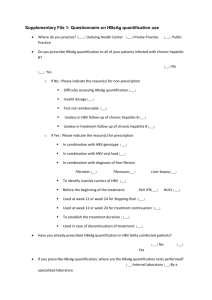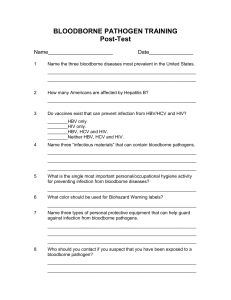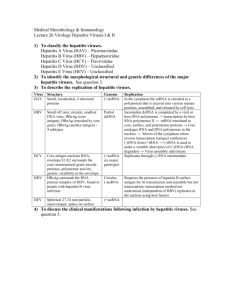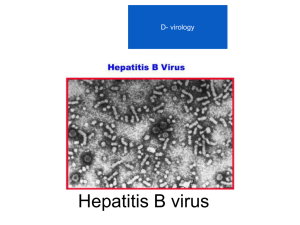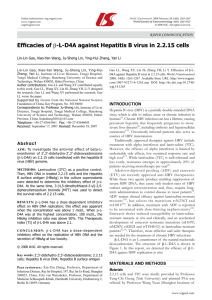pubdoc_3_31264_349
advertisement
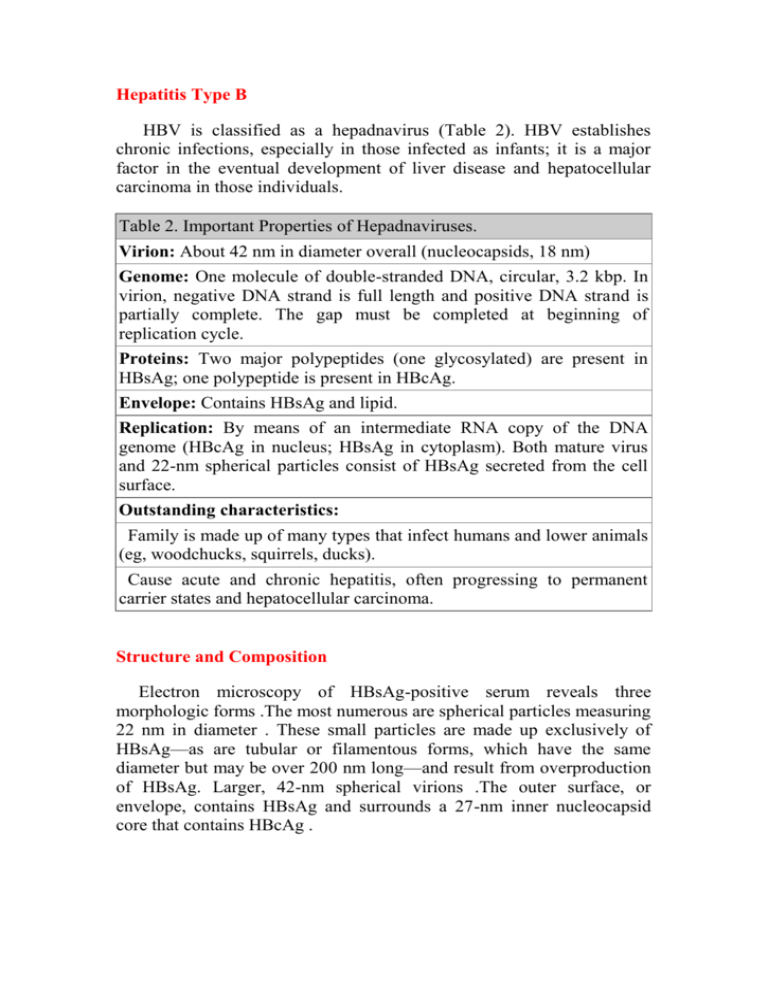
Hepatitis Type B HBV is classified as a hepadnavirus (Table 2). HBV establishes chronic infections, especially in those infected as infants; it is a major factor in the eventual development of liver disease and hepatocellular carcinoma in those individuals. Table 2. Important Properties of Hepadnaviruses. Virion: About 42 nm in diameter overall (nucleocapsids, 18 nm) Genome: One molecule of double-stranded DNA, circular, 3.2 kbp. In virion, negative DNA strand is full length and positive DNA strand is partially complete. The gap must be completed at beginning of replication cycle. Proteins: Two major polypeptides (one glycosylated) are present in HBsAg; one polypeptide is present in HBcAg. Envelope: Contains HBsAg and lipid. Replication: By means of an intermediate RNA copy of the DNA genome (HBcAg in nucleus; HBsAg in cytoplasm). Both mature virus and 22-nm spherical particles consist of HBsAg secreted from the cell surface. Outstanding characteristics: Family is made up of many types that infect humans and lower animals (eg, woodchucks, squirrels, ducks). Cause acute and chronic hepatitis, often progressing to permanent carrier states and hepatocellular carcinoma. Structure and Composition Electron microscopy of HBsAg-positive serum reveals three morphologic forms .The most numerous are spherical particles measuring 22 nm in diameter . These small particles are made up exclusively of HBsAg––as are tubular or filamentous forms, which have the same diameter but may be over 200 nm long––and result from overproduction of HBsAg. Larger, 42-nm spherical virions .The outer surface, or envelope, contains HBsAg and surrounds a 27-nm inner nucleocapsid core that contains HBcAg . Replication of Hepatitis B Virus The infectious virion attaches to cells and becomes uncoated . In the nucleus, the partially double-stranded viral genome is converted to covalently closed circular double-stranded DNA (cccDNA). The cccDNA serves as template for all viral transcripts, including a 3.5-kb pregenome RNA. The pregenome RNA becomes encapsidated with newly synthesized HBcAg. Within the cores, the viral polymerase synthesizes by reverse transcription a negative-strand DNA copy. The polymerase starts to synthesize the positive DNA strand, but the process is not completed. Cores bud from the pre-Golgi membranes, acquiring HBsAgcontaining envelopes, and may exit the cell. Alternatively, cores may be reimported into the nucleus and initiate another round of replication in the same cell. Hepatitis Type C Clinical and epidemiologic studies and cross-challenge experiments had suggested that there were several non-A, non-B (NANB) hepatitis agents which, based on serologic tests, were not related to HAV or HBV. The major agent was identified as hepatitis C virus (HCV). HCV is a positive-stranded RNA virus, classified as family Flaviviridae, genus Hepacivirus. Various viruses can be differentiated by RNA sequence analysis into at least six major genotypes (clades) and more than 100 subtypes. Clades differ from each other by 25–35% at the nucleotide level; subtypes differ from each other by 15–25%. The genome is 9.4 kb in size and encodes a core protein, two envelope glycoproteins, and several nonstructural proteins . The expression of cDNA clones of HCV in yeast led to the development of serologic tests for antibodies to HCV. Most cases of posttransfusion NANB hepatitis were caused by HCV. Hepatitis Type D (Delta Hepatitis) An antigen-antibody system termed the delta antigen (delta-Ag) and antibody (anti-delta) is detected in some HBV infections. The antigen is found within certain HBsAg particles. In blood, HDV (delta agent) contains delta-Ag (HDAg) surrounded by an HBsAg envelope. It has a particle size of 35–37 nm and a buoyant density of 1.24–1.25 g/mL in CsCl. The genome of HDV consists of single-stranded, circular, negativesense RNA, 1.7 kb in size. It is the smallest of known human pathogens and resembles subviral plant pathogens, ie, viroids. No homology exists with the HBV genome. HDAg is the only protein coded for by HDV RNA and is distinct from the antigenic determinants of HBV. HDV is a defective virus that acquires an HBsAg coat for transmission. It is often associated with the most severe forms of hepatitis in HBsAg-positive patients. Hepatitis Type E Hepatitis E virus (HEV) is transmitted enterically and occurs in epidemic form in developing countries, where water or food supplies are sometimes fecally contaminated. It was first documented in samples collected during the New Delhi outbreak of 1955. Pregnant women may have a high (20%) mortality rate if hepatitis develops. The viral genome has been cloned and is a positive-sense, single-stranded RNA 7.6 kb in size. It has been categorized in an unclassified genus called Hepevirus. Animal strains of HEV are common throughout the world. There is evidence of HEV or HEV-like infections in rodents, pigs, sheep, and cattle in the United States. There is the possibility of spread of virus from animals to humans. Pathology Hepatitis is a general term meaning inflammation of the liver. Microscopically, there is spotty parenchymal cell degeneration, with necrosis of hepatocytes, a diffuse lobular inflammatory reaction, and disruption of liver cell cords. These parenchymal changes are accompanied by reticuloendothelial (Kupffer) cell hyperplasia, periportal infiltration by mononuclear cells, and cell degeneration. Localized areas of necrosis are frequently observed. Later in the course of the disease, there is an accumulation of macrophages near degenerating hepatocytes. Preservation of the reticulum framework allows hepatocyte regeneration so that the highly ordered architecture of the liver lobule can be ultimately regained. The damaged hepatic tissue is usually restored in 8– 12 weeks. Histologically, the lobular architecture is preserved, with portal inflammation, swollen and pale hepatocytes (cobblestone arrangement), and slight to absent fibrosis. This lesion is frequently observed in asymptomatic carriers, usually does not progress toward cirrhosis, and has a favorable prognosis. Chronic active hepatitis features a spectrum of histologic changes from inflammation and necrosis to collapse of the normal reticulum framework with bridging between the portal triads or terminal hepatic veins. HBV is detected in 10–50% of these patients. Both HBV and HCV have significant roles in the development of hepatocellular carcinoma that may appear many (15–60) years after establishment of chronic infection. Treatment Treatment of patients with hepatitis is supportive and directed at allowing hepatocellular damage to resolve and repair itself. Only HBV and HCV have specific treatments, and those are only partially effective. Recombinant interferon-alfa is currently the therapy of proved benefit in the treatment of patients chronically infected with HBV or HCV. Several antiviral drugs are being tested against chronic hepatitis infections. Lamivudine, a reverse transcriptase inhibitor , reduces HBV DNA levels, but viral replication resumes in the majority of patients when treatment is stopped and resistant virus mutants are selected. Orthotopic liver transplantation is a treatment for chronic hepatitis B and C end-stage liver damage Prevention & Control Viral vaccines and protective immune globulin preparations are available against HAV and HBV. Neither type of reagent is currently available to prevent HCV infections.



